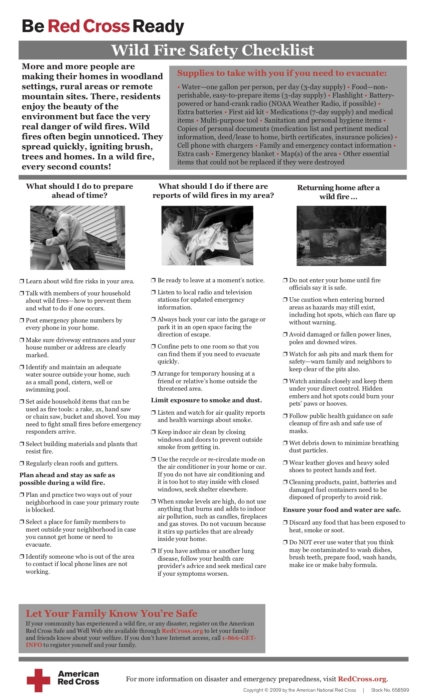A wildfire is an unplanned, unwanted fire burning in a natural area, such as a forest, grassland, or prairie. As building development expands into these areas, homes and businesses may be situated in or near areas susceptible to wildfires. This is called the wildland urban interface.
Wildfires can cause death or injury to people and animals, damage or destroy structures, and disrupt community services including transportation, gas, power, communications, and other services. The impact may cover large areas with extensive burning, embers traveling more than a mile away from the wildfire itself, and smoke causing health issues for people far away from the fire. Wildfires damage watersheds leave areas prone to flooding and mudslides for many years.
Here are some actions to take if you receive a fire weather watch alert from the National Weather Service for your local area and what to do before, during, and after a wildfire. Be sure to check out the Red Cross safety tips.


Make a Wildfire plan
- Know your wildfire risk.
- Familiarize yourself with local emergency plans. Know where to go and how to get there should you need to evacuate.
- Make a wildfire emergency plan including an evacuation plan and a communication plan.
- Many communities have text or email alerting systems for emergency notifications. To find out what alerts are available in your area, search the Internet with your town, city, or county name and the word “alerts.”
- Build or restock your emergency preparedness kit, including a flashlight, batteries, cash, and first aid supplies.
- Stay tuned to your phone alerts, TV, or radio, for weather updates, emergency instructions or evacuation orders.
Prepare Your Home
- Create and maintain an area approximately 30’ away from you home that is free of anything that will burn, such as wood piles, dried leaves, newspapers, brush, and other landscaping that can burn. From 30 feet to 100 feet reduce or replace as much of the most flammable vegetation as possible and prune vegetation, create “fuel breaks,” such as driveways, gravel walkways, and lawns. Work with neighbors to create spaces up to 200 feet around your homes where vegetation is thinned to remove underbrush and tall trees do not touch each other for continuous canopies.
- Regularly clean the roof and gutters.
- Connect garden hoses long enough to reach any area of the home and fill garbage cans, tubs, or other large containers with water.
- Review your homeowner’s insurance policy and also prepare/update a list of your home’s contents.
During a Wildfire
- If there is a wildfire in the area, be ready to evacuate on short notice.
- If you see a wildfire and haven’t received evacuation orders yet, call 9-1-1. Don’t assume that someone else has already called.
- If ordered to evacuate during a wildfire, do it immediately- make sure and tell someone where you are going and when you have arrived.
- If you or someone you are with has been burned, call 9-1-1 or seek help immediately; cool and cover burns to reduce chance of further injury or infection.
After a Wildfire
Returning Home
- Return home only when authorities say it is safe.
- For several hours after the fire, maintain a “fire watch.” Check and re-check for smoke, sparks or hidden embers throughout the house, including the roof and the attic.
- Use caution when entering burned areas as hazards may still exist, including hot spots, which can flare up without warning. Evacuate immediately if you smell smoke.
Cleaning Your Home
- Wear a NIOSH certified-respirator (dust mask) and wet debris down to minimize breathing dust particles.
- Discard any food that has been exposed to heat, smoke or soot.
- Do NOT use water that you think may be contaminated to wash dishes, brush teeth, prepare food, wash hands, or to make ice or baby formula.
- Photograph damage to your property for insurance purposes.
For more information click here .
